*UPDATED May 10, 2016: My updates are in BOLD
I’m going to let the cat out of the bag right now and say that Tom Hardy’s reeds are my favorite reeds. I could play on them all day. They are everything I want a reed to be. I’ve been given old reeds by a few top tier bassoonists, and Tom’s reeds are every bit as good as those reeds were. I’m shocked that reeds made in England work so amazingly in the Rocky Mountains. And not only are the reeds phenomenal, but so are the resources Mr. Hardy has available on his website and YouTube–but more about those later.
The reeds came in a small box via airmail. I was a little worried about their condition after such a long journey, but the layers of cotton the reeds were wrapped in protected them perfectly.
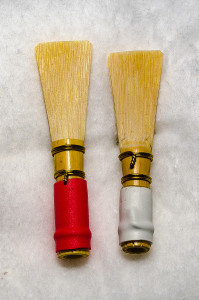
Mr. Hardy sent me two reeds. I liked them both, but they are quite different reeds. The red reed is intended for Fox, Adler, Schreiber, and some Puchner players. The white reed is for Heckel and Moosmann players, as the reeds are smaller and more resistant. I didn’t know this about the reeds before I tested them, but as you will see, my results were consistent with this advice.
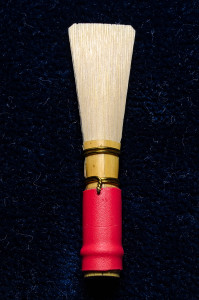
The red reed fit on all of my bocals perfectly. It was free-blowing, had great response in all registers, and sounded wonderful. The only downside was that it was flat.
- D in the staff: 5 cents flat
- A at the top of the staff: 20 cents flat
- Low F: perfectly in tune
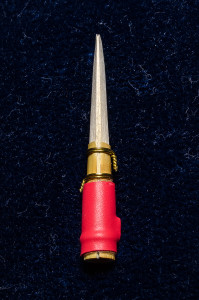
It was flat on both my Fox 201 and 220. I tried it on my student’s Fox 240 and it was a little better (about 2-3 cents sharper), but still slightly on the low side. I ended up cutting the tip back in order to raise the pitch. I was worried that this would throw all of the dimensions out of whack and that the reed would be ruined, but it wasn’t. It was fine. I thinned the newly cut tip with some sandpaper and that was it.
I played on this reed in a faculty trio recital. It did a wonderful job. I had to play all kinds of crazy stuff, including huge staccato leaps and accents (Valerie Coleman’s Rubispheres). This reed played them all without any trouble. I used this reed again the next week during a four hour rehearsal. My embouchure didn’t tire.
One of my students showed up with four of these red reeds last week. One was perfectly in tune and the other three were flat. I trimmed the flat ones, and they have been working perfectly. These reeds were all just as good as the one Mr. Hardy sent me for my initial review.
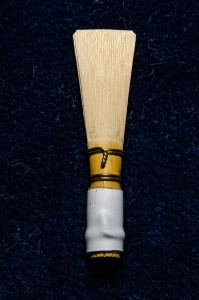
The white reed also fit on all bocals snugly, had great response up and down the range of the bassoon, and had a beautiful sound. It was more resistant than the red reed, but in a good way. It was the kind of resistance that comes along with a great, dark sound.
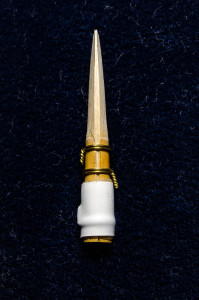
This white reed hit the bullseye on intonation:
- D in the staff: perfectly in tune
- A at the top of the staff: perfectly in tune
- Low F: 2 cents sharp
What else can I say? I’m in love with this reed. I described it to my husband as, “as good as the top 25% of reeds I make for myself.” I played this reed in a performance this past weekend. It did a great job. The orchestra was accompanying a choir of 300+, and everyone was playing way too loud. The increased resistance of this reed allowed me to hold my own (particularly in the four measures where the bassoons were actually heard).
As far as red vs white reeds go, Mr. Hardy is happy to advise you on which reed will work best for your bassoon/bocal combination. I play a Fox 201 with a Heckel bocal, so he actually recommended the white reed for me, even though he typically recommends the red reed for Fox bassoons. Email him before you order to get his take on your unique situation. In the future I will order both red and white reeds. I like the red reeds for chamber music and extra long playing days (I don’t tire on them as easily). I like the white reeds for orchestral playing.
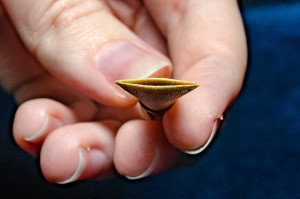
These were the only reeds I received for my blog reviews that had what I consider to be a finished tip (it’s thinner than it looks in the picture). These reeds were truly ready for use right out of the box. I could have used the reeds I received for a performance without making any adjustments. That’s simply amazing.
What’s the way to make a fantastic reed even better? How about a series of very helpful YouTube videos about how to adjust reeds and even make these very reeds for yourself? Tom Hardy is working on a series of these videos. Many of them are already available. Check out his YouTube channel. His website also has useful information about teaching, bassoons he likes, etc.
These reeds are available for purchase on his website. Click on the “buy this item” link under the picture of the reeds. Each reed costs £15 (about $20, but the exchange rate changes every day). Shipping is £5 for UK customers and £10 for US customers (if you live elsewhere, email him for a shipping quote). The checkout process on the website can be a little finicky, but don’t let that deter you! If it doesn’t work, email Mr. Hardy directly.
These reeds are definitely worth your time and money to try. Let me know how you like them in the comments below!
[…] When my student told me she was going to order three more, I tried to get her to order from Tom Hardy instead. But she was in a desperate reed situation and needed the speed and convenience that Amazon […]
I really appreciate all of these reviews! I have been asked multiple times by friends that are music teachers about reeds for their students and have been able to direct them to this blog. Check out the other parts of the blog as well. There are so many helpful tips and tricks and useful things on here!
I’m glad it has been useful for you and your music teacher friends! Thank you for your comment! Hope you are well.